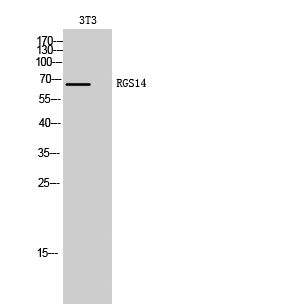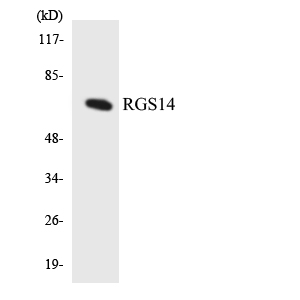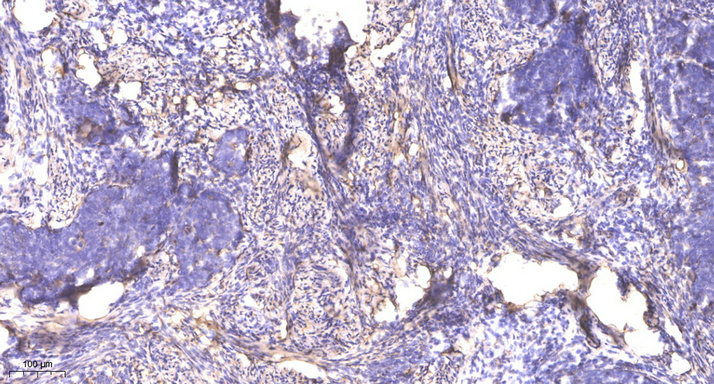RGS14 Polyclonal Antibody
- Catalog No.:YT4073
- Applications:WB;ELISA;IHC
- Reactivity:Human;Mouse;Rat
- Target:
- RGS14
- Fields:
- >>Rap1 signaling pathway
- Gene Name:
- RGS14
- Protein Name:
- Regulator of G-protein signaling 14
- Human Gene Id:
- 10636
- Human Swiss Prot No:
- O43566
- Mouse Gene Id:
- 51791
- Mouse Swiss Prot No:
- P97492
- Rat Gene Id:
- 114705
- Rat Swiss Prot No:
- O08773
- Immunogen:
- The antiserum was produced against synthesized peptide derived from human RGS14. AA range:125-174
- Specificity:
- RGS14 Polyclonal Antibody detects endogenous levels of RGS14 protein.
- Formulation:
- Liquid in PBS containing 50% glycerol, 0.5% BSA and 0.02% sodium azide.
- Source:
- Polyclonal, Rabbit,IgG
- Dilution:
- WB 1:500-2000;IHC 1:50-300; ELISA 2000-20000
- Purification:
- The antibody was affinity-purified from rabbit antiserum by affinity-chromatography using epitope-specific immunogen.
- Concentration:
- 1 mg/ml
- Storage Stability:
- -15°C to -25°C/1 year(Do not lower than -25°C)
- Other Name:
- RGS14;Regulator of G-protein signaling 14;RGS14
- Observed Band(KD):
- 65kD
- Background:
- This gene encodes a member of the regulator of G-protein signaling family. This protein contains one RGS domain, two Raf-like Ras-binding domains (RBDs), and one GoLoco domain. The protein attenuates the signaling activity of G-proteins by binding, through its GoLoco domain, to specific types of activated, GTP-bound G alpha subunits. Acting as a GTPase activating protein (GAP), the protein increases the rate of conversion of the GTP to GDP. This hydrolysis allows the G alpha subunits to bind G beta/gamma subunit heterodimers, forming inactive G-protein heterotrimers, thereby terminating the signal. Alternate transcriptional splice variants of this gene have been observed but have not been thoroughly characterized. [provided by RefSeq, Jul 2008],
- Function:
- function:Inhibits signal transduction by increasing the GTPase activity of G protein alpha subunits thereby driving them into their inactive GDP-bound form.,similarity:Contains 1 GoLoco domain.,similarity:Contains 1 RGS domain.,similarity:Contains 2 RBD (Ras-binding) domains.,
- Subcellular Location:
- Nucleus . Nucleus, PML body . Cytoplasm . Membrane . Cell membrane . Cytoplasm, cytoskeleton, microtubule organizing center, centrosome . Cytoplasm, cytoskeleton, spindle . Cytoplasm, cytoskeleton, spindle pole . Cell projection, dendrite . Cell projection, dendritic spine . Cell junction, synapse, postsynaptic density . Associates with the perinuclear sheaths of microtubules (MTs) surrounding the pronuclei, prior to segregating to the anastral mitotic apparatus and subsequently the barrel-shaped cytoplasmic bridge between the nascent nuclei of the emerging 2-cell embryo. Localizes to a perinuclear compartment near the microtubule-organizing center (MTOC). Expressed in the nucleus during interphase and segregates to the centrosomes and astral MTs during mitosis. Relocalizes to the nucleus
- Expression:
- Brain,Caudate nucleus,Colon,
- June 19-2018
- WESTERN IMMUNOBLOTTING PROTOCOL
- June 19-2018
- IMMUNOHISTOCHEMISTRY-PARAFFIN PROTOCOL
- June 19-2018
- IMMUNOFLUORESCENCE PROTOCOL
- September 08-2020
- FLOW-CYTOMEYRT-PROTOCOL
- May 20-2022
- Cell-Based ELISA│解您多样本WB检测之困扰
- July 13-2018
- CELL-BASED-ELISA-PROTOCOL-FOR-ACETYL-PROTEIN
- July 13-2018
- CELL-BASED-ELISA-PROTOCOL-FOR-PHOSPHO-PROTEIN
- July 13-2018
- Antibody-FAQs
- Products Images

- Western Blot analysis of 3T3 cells using RGS14 Polyclonal Antibody cells nucleus extracted by Minute TM Cytoplasmic and Nuclear Fractionation kit (SC-003,Inventbiotech,MN,USA).

- Western blot analysis of the lysates from HUVECcells using RGS14 antibody.

- Immunohistochemical analysis of paraffin-embedded human cervical carcinoma. 1, Antibody was diluted at 1:200(4° overnight). 2, Tris-EDTA,pH9.0 was used for antigen retrieval. 3,Secondary antibody was diluted at 1:200(room temperature, 45min).



